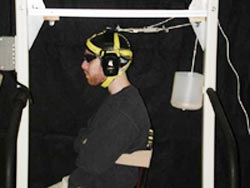Trusted head injury prevention technique debunked

Force Application Trial Set-up. Photo Courtesy of Ryan T. Tierney, PhD, Temple University.
Contrary to popular thinking in athletics, traditional neck muscle resistance training may not protect athletes from head injuries.
For eight weeks, kinesiologists at Temple University worked with male and female Division I intercollegiate soccer players to see if a resistance training program would reduce the player’s head acceleration during impact. According to Ryan Tierney PhD, director of Temple’s Graduate Athletic Training Program, head impacts experienced during soccer cause head acceleration, similar to what a person experiences during a car crash. These impacts may cause mental impairment or accumulate and lead to permanent disability.
His findings are published in the current issue of the Journal of Athletic Training and will be highlighted at the Eastern Athletic Trainers’ Association’s Annual Meeting in Philadelphia, Pa, January 7-10.
“We did see a change in the player’s neck muscle strength but these changes made absolutely no difference in their ability to stabilize their heads when force was applied,” said Tierney.
Every year, 1.4 million Americans suffer from a traumatic brain injury caused by a blow or jolt to the head. Moreover, previous research conducted by Tierney found that women are more susceptible to these types of injuries than men. Before Tierney’s latest findings, many scholars and trainers believed that resistance training could reduce these instances among drivers, firearm users and those who participate in sports.
Though traditional resistance training failed with this group, Tierney does not rule out the possibility that other types of training such as plyometrics (higher intensity exercises used to develop power that involve explosive muscular contractions) could be used to combat this problem.
Media Contact
All latest news from the category: Health and Medicine
This subject area encompasses research and studies in the field of human medicine.
Among the wide-ranging list of topics covered here are anesthesiology, anatomy, surgery, human genetics, hygiene and environmental medicine, internal medicine, neurology, pharmacology, physiology, urology and dental medicine.
Newest articles

Trotting robots reveal emergence of animal gait transitions
A four-legged robot trained with machine learning by EPFL researchers has learned to avoid falls by spontaneously switching between walking, trotting, and pronking – a milestone for roboticists as well…

Innovation promises to prevent power pole-top fires
Engineers in Australia have found a new way to make power-pole insulators resistant to fire and electrical sparking, promising to prevent dangerous pole-top fires and reduce blackouts. Pole-top fires pose…

Possible alternative to antibiotics produced by bacteria
Antibacterial substance from staphylococci discovered with new mechanism of action against natural competitors. Many bacteria produce substances to gain an advantage over competitors in their highly competitive natural environment. Researchers…





















